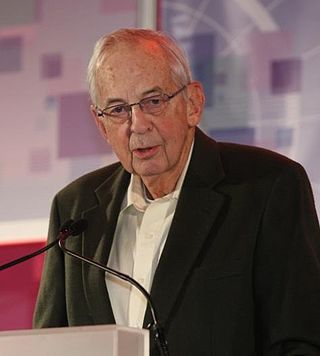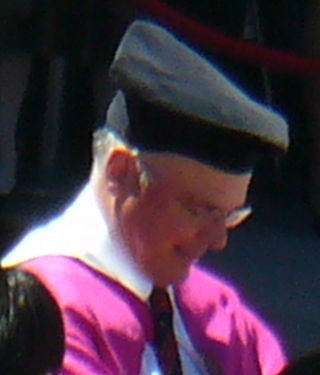Optica is a professional society of individuals and companies with an interest in optics and photonics. It publishes journals, organizes conferences and exhibitions, and carries out charitable activities.
Xi-Cheng Zhang is a Chinese-born American physicist, currently serving as the Parker Givens Chair of Optics at the University of Rochester, and the director of the Institute of Optics. He is also the Chairman of the Board and President of Zomega Terahertz Corporation.
Rod C. Alferness was president of The Optical Society in 2008.
Eric Van Stryland was president of the Optical Society of America in 2005.

Anthony Michael Johnson is an American experimental physicist, a professor of physics, and a professor of computer science and electrical engineering at the University of Maryland, Baltimore County (UMBC). He is the director of the Center for Advanced Studies in Photonics Research (CASPR), also situated on campus at UMBC. Since his election to the 2002 term as president of the Optical Society, formerly the Optical Society of America, Johnson has the distinction of being the first and only African-American president to date. Johnson's research interests include the ultrafast photophysics and nonlinear optical properties of bulk, nanostructured, and quantum well semiconductor structures, ultrashort pulse propagation in fibers and high-speed lightwave systems. His research has helped to better understand processes that occur in ultrafast time frames of 1 quadrillionth of a second. Ultrashort pulses of light have been used to address technical and logistical challenges in medicine, telecommunications, homeland security, and have many other applications that enhance contemporary life.
Anthony E. Siegman was an electrical engineer and educator at Stanford University who investigated and taught about masers and lasers. Known to almost all as Tony Siegman, he was president of the Optical Society of America [now Optica (society)] in 1999 and was awarded the Esther Hoffman Beller Medal in 2009.
The IEEE Photonics Award is a Technical Field Award established by the IEEE Board of Directors in 2002. This award is presented for outstanding achievements in photonics, including work relating to: light-generation, transmission, deflection, amplification and detection and the optical/electro-optical componentry and instrumentation used to accomplish these functions. Also included are storage technologies utilizing photonics to read or write data and optical display technologies. It also extends from energy generation/propagation, communications, information processing, storage and display, biomedical and medical uses of light and measurement applications.

Constance J. Chang-Hasnain is chairperson and founder of Berxel Photonics Co. Ltd. and Whinnery Professor Emerita of the University of California, Berkeley. She was President of Optica in 2021.

Amnon Yariv is an Israeli-American professor of applied physics and electrical engineering at Caltech, known for innovations in optoelectronics. Yariv obtained his B.S., M.S. and PhD. in electrical engineering from University of California, Berkeley in 1954, 1956 and 1958, respectively.

Robert William Boyd is an American physicist noted for his work in optical physics and especially in nonlinear optics. He is currently the Canada Excellence Research Chair Laureate in Quantum Nonlinear Optics based at the University of Ottawa, professor of physics cross-appointed to the school of electrical engineering and computer science at the University of Ottawa, and professor of optics and professor of physics at the University of Rochester.

James Power Gordon was an American physicist known for his work in the fields of optics and quantum electronics. His contributions include the design, analysis and construction of the first maser in 1954 as a doctoral student at Columbia University under the supervision of C. H. Townes, development of the quantal equivalent of Shannon's information capacity formula in 1962, development of the theory for the diffusion of atoms in an optical trap in 1980, and the discovery of what is now known as the Gordon-Haus effect in soliton transmission, together with H. A. Haus in 1986. Gordon was a member of the National Academy of Engineering and the National Academy of Sciences.
Andrea Alù is an Italian American scientist and engineer, currently Einstein Professor of Physics at The City University of New York Graduate Center. He is known for his contributions to the fields of optics, photonics, plasmonics, and acoustics, most notably in the context of metamaterials and metasurfaces. He has co-authored over 650 journal papers and 35 book chapters, and he holds 11 U.S. patents.

Lightwave Electronics Corporation was a developer and manufacturer of diode-pumped solid-state lasers, and was a significant contributor to the creation and maturation of this technology. Lightwave Electronics was a technology-focused company, with diverse markets, including science and micromachining. Inventors employed by Lightwave Electronics received 51 US patents, and Lightwave Electronics products were referenced by non-affiliated inventors in 91 US patents.

David A. B. Miller is the W. M. Keck Foundation Professor of Electrical Engineering at Stanford University, where he is also a professor of Applied Physics by courtesy. His research interests include the use of optics in switching, interconnection, communications, computing, and sensing systems, physics and applications of quantum well optics and optoelectronics, and fundamental features and limits for optics and nanophotonics in communications and information processing.
Kenju Otsuka is a Japanese engineer and physicist concerned with lasers and quantum electronics.
Jelena Vučković is a Serbian-born American professor and a courtesy faculty member in the Department of Applied Physics at Stanford University. She served as Fortinet Founders Chair of the Department of Electrical Engineering at Stanford University from August 2021 through June 2023. Vučković leads the Nanoscale and Quantum Photonics (NQP) Lab, and is a faculty member of the Ginzton Lab, PULSE Institute, SIMES Institute, and Bio-X at Stanford. She was the inaugural director of the Q-FARM initiative. She is a Member of the National Academy of Sciences, and a Fellow of The Optical Society, the American Physical Society and the Institute of Electrical and Electronics Engineers.
Govind P. Agrawal is an Indian American physicist and a fellow of Optica, Life Fellow of the IEEE, and Distinguished Fellow of the Optical Society of India. He is the recipient of James C. Wyant Professorship of Optics at the Institute of Optics and a professor of physics at the University of Rochester. He is also a Distinguished scientist at the Laboratory for Laser Energetics (LLE) in the University of Rochester. Agrawal has authored and co-authored several highly cited books in the fields of non-linear fiber optics, optical communications, and semiconductor lasers.
Peter J. Delfyett Jr is an American engineer and Pegasus Professor and Trustee Chair Professor of Optics, ECE & Physics at the University of Central Florida College of Optics and Photonics.
Alexander Luis Gaeta is an American physicist and the David M. Rickey Professor of Applied Physics at Columbia University. He is known for his work on quantum and nonlinear photonics. He is a Fellow of the American Physical Society, Optica, and of the Institute of Electrical and Electronics Engineers.

Randy Alan Bartels is an American investigator at the Morgridge Institute for Research and a professor of Biomedical Engineering at the University of Wisconsin–Madison. He has been awarded the Adolph Lomb Medal from the Optical Society of America, a National Science Foundation CAREER award, a Sloan Research Fellowship in physics, an Office of Naval Research Young Investigator Award, a Beckman Young Investigator Award, and a Presidential Early Career Award for Science and Engineering (PECASE). In 2020 and 2022, he received support from the Chan Zuckerberg Initiative to develop microscope technologies for imaging tissues and cells.








